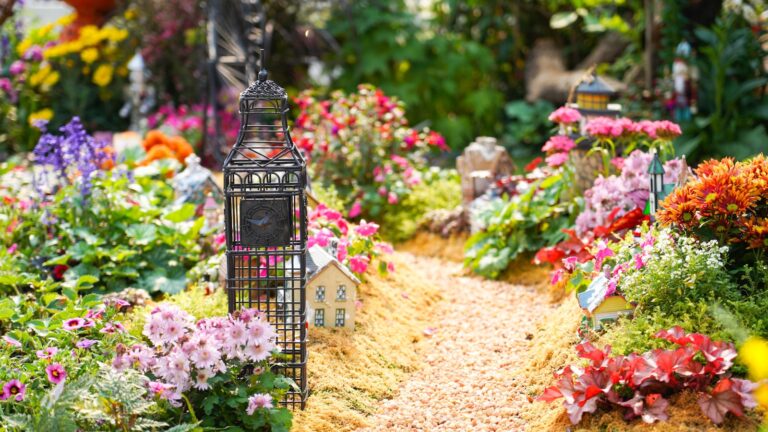How Gardening Traditions Differ Across Cultures?
When I first became interested in gardening, I assumed there was a “right way” to do things. I’d flip through gardening books, follow online tutorials, and try to copy exactly what I saw. It wasn’t until I traveled and saw gardens in different countries that I realized something profound: gardening isn’t universal. The way people interact with plants, design their spaces, and think about their relationship with nature varies dramatically across cultures and reflects deep-rooted values, history, and practical adaptations to local environments.
These differences go far beyond simply growing different plants in different climates. They reveal how various societies view beauty, their relationship with nature, and even their understanding of humanity’s place in the world. From the meticulously raked gravel of Japanese Zen gardens to the productive chaos of traditional African companion planting, these varied approaches tell us as much about cultural values as they do about horticulture.
In this exploration of global gardening traditions, we’ll travel across continents and through centuries to understand how and why people garden differently. Whether you’re a passionate gardener looking to draw inspiration from other traditions or simply curious about how culture shapes our relationship with plants, there’s something fascinating to discover in the world’s diverse approaches to tending the earth.
Eastern Philosophical Gardens: Meaning in Every Element

In many East Asian cultures, gardens aren’t just places of beauty or utility—they’re philosophical statements, physical manifestations of spiritual beliefs, and spaces designed for contemplation as much as appreciation.
Japanese Gardens: The Art of Suggestion
Japanese gardens might be some of the most instantly recognizable in the world. Their carefully placed rocks, raked gravel, pruned trees, and tranquil water features create spaces that feel both meticulously maintained and somehow natural. But what makes these gardens so distinctive isn’t just their appearance—it’s the philosophy behind them.
Unlike Western gardens that often aim to impress through abundance, Japanese gardens practice the art of suggestion. They don’t try to display all of nature but instead create miniature idealized landscapes that hint at greater natural scenes.
According to Dr. Seiko Goto, landscape architecture historian at Rutgers University, “Japanese gardens don’t try to copy nature exactly; they try to capture its essence. A few carefully placed rocks might represent mountains, while a small pond stands in for the ocean. The viewer’s imagination completes the scene.” This approach reflects the Zen Buddhist concept of “ma”—the meaningful space or interval between elements.
The techniques used in Japanese gardening have remained remarkably consistent for centuries. The oldest existing Japanese garden manual, Sakuteiki (Records of Garden Making), was written in the 11th century but describes principles still followed today:
- Asymmetrical design that avoids perfect symmetry
- Careful pruning that appears natural rather than obviously shaped
- Use of “borrowed scenery” (shakkei) that incorporates distant landscapes into the garden view
- Restraint in plant selection, often focusing on different shades of green rather than colorful flowers
These techniques reflect cultural values that prize suggestion over statement, subtlety over display, and harmony with nature rather than dominance over it.
Chinese Gardens: Creating Miniature Worlds
Chinese garden traditions share some philosophical roots with Japanese gardens but express them quite differently. While Japanese gardens often embrace minimalism, traditional Chinese scholars’ gardens create intricate miniature landscapes complete with buildings, waterways, artificial mountains, and carefully selected plants.
These gardens reached their peak during the Ming Dynasty (1368-1644) when wealthy scholars and officials created private garden retreats. Unlike the vast public gardens of Europe, these were intimate spaces designed for contemplation, artistic inspiration, and entertaining like-minded friends.
The famous Humble Administrator’s Garden in Suzhou, built in the early 16th century, exemplifies this tradition. Despite its name, there’s nothing humble about this 13-acre masterpiece with its numerous pavilions, bridges, and carefully composed views. Each turn in the garden path reveals a new scene, like walking through a three-dimensional landscape painting.
As Dr. Bianca Maria Rinaldi explains in her book “The Chinese Garden,” these spaces were “gardens of the mind as much as gardens of plants. They were designed to stimulate poetry, painting, and philosophical conversation.” This approach reflects the Taoist value of finding harmony between opposing forces—the built environment and natural elements, movement and stillness, complexity and simplicity.
Plant selection in traditional Chinese gardens emphasizes symbolic meaning over pure aesthetics:
- Bamboo represents resilience and integrity because it bends without breaking
- Peonies symbolize wealth and honor
- Lotus flowers, which rise pure from muddy water, represent spiritual enlightenment
- Pine trees, which stay green in winter, symbolize longevity and persistence
A 2017 study published in the Journal of Landscape Architecture found that symbolic plants appear in over 90% of classical Chinese gardens, demonstrating how cultural meaning shapes garden design across centuries.
Mediterranean Gardens: Blending Beauty with Utility
The Mediterranean region—spanning Southern Europe, North Africa, and parts of the Middle East—has developed distinctive gardening traditions shaped by climate, history, and the practical needs of daily life.
Italian Renaissance Gardens: Mathematical Harmony
Italian Renaissance gardens of the 15th and 16th centuries represent one of history’s most influential garden styles. Unlike the nature-mimicking approaches of East Asia, these gardens imposed geometric order on the landscape, reflecting Renaissance ideals about humanity’s ability to improve upon nature through reason and mathematics.
Villa d’Este near Rome, created in the 1550s, exemplifies this tradition with its terraced design, straight pathways, geometric flowerbeds, and spectacular fountains. The garden is designed to be viewed from above, with the main villa positioned to overlook the entire symmetrical layout—a physical representation of human mastery over the natural world.
Dr. Elizabeth Hyde, garden historian at Princeton University, explains: “Renaissance gardens weren’t trying to imitate wild nature but to demonstrate how human intellect could perfect nature through proportion, symmetry, and order. They were showcases for both artistic and engineering prowess.”
These gardens relied heavily on:
- Topiary (pruned shrubs in geometric or figurative shapes)
- Parterre (ornamental arrangement of flowerbeds)
- Water features demonstrating hydraulic engineering
- Classical statuary and architectural elements
But Renaissance gardens weren’t only about display. Many included practical elements like herb gardens and orchards, reflecting the Mediterranean tradition of blending the decorative with the useful.
Spanish Courtyard Gardens: Private Oases
While Italian gardens often unfolded across hillsides in grand displays, traditional Spanish gardens took a more intimate, inward-focused approach. The classic Spanish patio garden, with roots in both Roman and Islamic traditions, creates a private green sanctuary within the walls of the home.
The famous courtyards of Córdoba, Spain, demonstrate this approach beautifully. Each May, residents open their private patios to visitors during the Festival de los Patios, revealing hidden gardens that transform modest homes into cool, fragrant retreats from the intense Andalusian heat.
These spaces typically feature:
- Central fountains or water features that provide cooling effects
- Potted plants rather than in-ground planting
- Tile work and vertical plantings to maximize small spaces
- Fragrant plants like jasmine and citrus
A 2019 survey by the Spanish Botanical Society found that traditional courtyard gardens in Córdoba maintain approximately 60% of the same plant species used in similar spaces during the 12th century—a remarkable continuity of gardening tradition across nearly a millennium.
Maria Castellano, an architect specializing in traditional Spanish housing, notes: “These aren’t gardens for show but for living. They turn the house inside out, making the outdoor space as important as any indoor room. During summer, many families essentially live in their patios, using them for cooking, dining, and socializing.”
Indigenous Gardening Traditions: Working With Nature’s Systems

Indigenous cultures worldwide have developed sophisticated gardening techniques that focus on working with natural systems rather than imposing order upon them. These approaches often blur the line between gardening and broader land management, viewing cultivation as participation in ecological relationships rather than a separate human activity.
Native American Three Sisters Gardening
One of the most ingenious agricultural systems ever developed is the “Three Sisters” companion planting method practiced by many Indigenous North American nations, including the Haudenosaunee (Iroquois) people.
This approach plants corn (maize), climbing beans, and squash together in a mutually beneficial relationship:
- Corn provides natural trellises for beans to climb
- Beans fix nitrogen in the soil, fertilizing the other plants
- Squash spreads along the ground, its broad leaves suppressing weeds and retaining soil moisture
Dr. Jane Mt. Pleasant, an agronomist and member of the Tuscarora Nation, has conducted research showing that Three Sisters gardens produce about 20% more food per acre than modern monocropping without requiring synthetic fertilizers. In a 2016 paper published in the American Journal of Agricultural Economics, she demonstrated that this system provides better nutrition per land unit than any single-crop approach.
This agricultural technique reflects cultural values that emphasize relationships and reciprocity. As Robin Wall Kimmerer, botanist and member of the Citizen Potawatomi Nation, explains in her book “Braiding Sweetgrass”: “In the Three Sisters garden, each plant does what it does best, and together they create a whole that exceeds the sum of its parts. The Sisters model how we might live.”
African Raised-Bed and Polyculture Systems
Across the diverse landscapes of Africa, traditional gardening systems demonstrate sophisticated ecological knowledge developed over millennia. One remarkable example is found in the raised-bed systems of the Ovambo people in what is now Namibia and Angola.
The Ovambo created intricate networks of raised growing beds separated by sunken pathways. During rare rainfall events, these pathways channel and collect water, directing it to plant roots while the raised beds prevent waterlogging. This ingenious system allows productive gardening in an environment receiving less than 600mm of rainfall annually.
Traditional West African garden systems often employ extreme polyculture—growing many different crops together in seemingly chaotic arrangements that actually represent sophisticated ecological engineering. A typical traditional Yoruba garden might contain over 60 different plant species in a small area.
Dr. Elias Ayuk of the United Nations University has documented how these polyculture systems reduce pest pressure by up to 60% compared to simplified cropping systems. A 2018 study in Agroforestry Systems showed that traditional polyculture gardens in Ghana maintain soil fertility without external inputs while providing food security throughout the year through staggered harvests.
Unlike European-style gardens with dedicated sections for flowers, vegetables, and herbs, these African systems typically integrate crops with different functions—food, medicine, fiber, and spiritual uses—creating multifunctional landscapes that serve multiple community needs simultaneously.
Middle Eastern Paradise Gardens: Finding Eden in the Desert
The word “paradise” itself comes from the Old Persian word “pairidaeza,” meaning an enclosed garden or park. This etymology hints at the profound importance of gardens in Middle Eastern cultures, where they represent not merely pleasant spaces but symbolic heavens on earth.
The Persian chahar bagh (four-garden) design, dating back at least to the 6th century BCE, features a quadrilateral layout divided by walkways or waterways that intersect at the center, often with a pavilion or fountain at this central point. This design spread throughout the Islamic world, appearing in spectacular form in gardens like the Alhambra in Granada, Spain.
What makes these gardens particularly remarkable is how they transformed hostile desert environments into lush sanctuaries. According to Dr. D. Fairchild Ruggles, historian of Islamic landscapes, “These weren’t just beautiful spaces but technological triumphs that demonstrated mastery of hydraulic engineering and horticultural knowledge.”
Key features of traditional Persian and Islamic gardens include:
- Sophisticated irrigation systems, including underground channels called qanats
- Emphasis on shade, fragrance, and the sound of flowing water
- Fruit trees that combine beauty with productivity
- Geometric layouts that represent cosmic order
Archaeological studies at Pasargadae, site of a 6th-century BCE Persian royal garden, have revealed irrigation systems capable of maintaining garden vegetation in an area receiving less than 250mm of annual rainfall—an extraordinary technological achievement for its time.
The sensory experience of these gardens was as important as their visual impact. Historian Dr. Penelope Hobhouse notes: “These were gardens meant to engage all senses—the sound of water, the scent of flowers, the taste of fruit, the feel of cool shade. They offered complete sensory contrast to the harsh desert environment beyond their walls.”
Colonial Encounters: Gardens as Cultural Exchange and Imposition
The age of exploration and colonization created unprecedented exchanges of plants, techniques, and gardening philosophies, often under conditions of extreme power imbalance. These encounters transformed gardening traditions worldwide, creating both losses of traditional knowledge and new hybrid forms of cultivation.
Botanical Gardens: Science and Empire
European colonial powers established botanical gardens throughout their empires, serving as sites for scientific research, agricultural experimentation, and displays of imperial power. Famous examples include the Royal Botanic Gardens in Kew (London), the Jardim Botânico in Rio de Janeiro, and the Bogor Botanical Gardens in Indonesia.
These institutions played crucial roles in the global transfer of economically valuable plants. Dr. Lucile Brockway’s research has documented how Kew Gardens facilitated the movement of rubber from Brazil to Southeast Asia, cinchona (source of quinine) from South America to India, and numerous other plants that reshaped global economies and landscapes.
A 2020 analysis by the World Economic Forum estimated that approximately 70% of food crops now grown worldwide are cultivated outside their regions of origin—a massive biological redistribution largely facilitated through colonial botanical networks.
While these exchanges created new opportunities, they also disrupted local economies and ecosystems. The transfer of rubber production from the Amazon to British Asian colonies devastated Brazil’s wild rubber industry while creating new plantation economies in Malaysia and Indonesia. Similarly, coffee’s movement from Ethiopia to Latin American plantations transformed landscapes and labor systems across continents.
Creolized Garden Traditions: Creative Adaptations
Despite the power imbalances of colonialism, gardening traditions in colonized regions often developed into rich hybrid forms that combined elements from multiple cultures. In the Caribbean, for example, enslaved Africans created “provision grounds” where they grew food for their own consumption, combining African cultivation techniques with New World crops and adaptations to local conditions.
These gardens frequently incorporated plants with dual food and medicinal purposes, reflecting African traditions where the distinction between food and medicine was less rigid than in European thinking. A study of traditional Jamaican home gardens by the University of the West Indies found that on average, 40% of plants in these spaces serve both culinary and medicinal functions.
Elizabeth Cunningham, historian of Caribbean gardens, notes: “These spaces weren’t just food sources but repositories of cultural memory and knowledge preservation. Through their gardens, enslaved people maintained connections to their African heritage while adapting to new environmental realities.”
Similar processes of gardening creolization occurred throughout colonized regions. Mexican jardines de traspatio (backyard gardens), Filipino hardin, and South African township gardens all demonstrate how colonized peoples adapted, resisted, and transformed imposed gardening models while maintaining elements of their own traditions.
Contemporary Global Gardens: Tradition in a Changing World
Modern gardening practices around the world reflect both the persistence of cultural traditions and the impacts of globalization, environmental concerns, and technological change. While distinctive cultural approaches remain evident, gardening traditions increasingly influence and borrow from one another in a complex global conversation.
Urban Agriculture: Necessity and Revival
Urban gardening traditions have roots in many cultures—from the chinampas (floating gardens) of Tenochtitlan (now Mexico City) to the market gardens that once surrounded Paris. Today, urban agriculture is experiencing a global revival that combines traditional knowledge with responses to contemporary challenges.
In Cuba, the organoponicos (urban organic gardens) that emerged during the economic crisis of the 1990s now produce over 70% of the fresh vegetables consumed in Havana, according to a 2021 report by the UN Food and Agriculture Organization. These gardens combine elements of traditional Cuban agriculture with modern agroecological science to create highly productive urban systems.
Similar movements have emerged worldwide, often with distinctive cultural inflections:
- Detroit’s urban farming movement connects to African American agricultural heritage
- Shanghai’s vertical farming builds on centuries of intensive Chinese gardening traditions
- Community gardens in immigrant neighborhoods often feature plants and techniques from participants’ countries of origin
A 2022 survey by the American Community Gardening Association found that 51% of community gardeners in the United States incorporate growing techniques from their cultural backgrounds, creating spaces where horticultural traditions are preserved and shared across generations.
Ecological Restoration Gardens: Healing Land and Culture
Indigenous communities worldwide are increasingly using gardening and ecological restoration as tools for cultural revitalization and environmental healing. These projects often explicitly reconnect traditional plant knowledge with contemporary environmental challenges.
The Native American Ethnobotany Database has documented over 10,000 uses of approximately 3,000 plants by Native North American peoples. This knowledge is now being applied in restoration projects like the Indigenous Cultural Landscapes initiative in the Chesapeake Bay region, which works to restore plant communities that supported Native American communities before European colonization.
Similar movements exist worldwide:
- Māori restoration of endemic plant communities in New Zealand
- Aboriginal fire management practices being reintroduced in Australia
- Maya forest garden restoration in Central America
These approaches represent what ethnobotanist Dr. Dennis Martinez calls “cultural restoration through ecological restoration”—healing not just landscapes but the human relationships with those landscapes disrupted by colonization and industrialization.
According to a 2023 report by the International Union for Conservation of Nature, Indigenous-led restoration projects show 20-30% higher biodiversity outcomes than conventional restoration approaches, demonstrating the ecological value of traditional gardening knowledge in addressing contemporary environmental challenges.
Conclusion: Gardens as Cultural Mirrors
As we’ve seen, gardening traditions around the world reflect fundamental cultural values and relationships with the natural world. Japanese gardens embody philosophical principles of suggestion and impermanence; formal European gardens display order and control; Indigenous food systems demonstrate ecological integration; and Islamic paradise gardens create sensory richness amid harsh environments.
These different approaches aren’t merely aesthetic preferences but represent profound differences in how cultures understand the proper relationship between humans and the rest of the natural world. Is nature something to be controlled, suggested, partnered with, or reverenced? The answer varies dramatically across gardening traditions.
In our contemporary era of environmental crisis and cultural exchange, these diverse gardening philosophies offer valuable perspectives as we reconsider our relationship with the planet. The ecological wisdom embedded in Indigenous gardening traditions, the sensory richness of Islamic gardens, the contemplative spaces of East Asian designs, and the artistry of Western formal gardens all contribute valuable elements to a global conversation about how humans can live well with plants.
Perhaps the most valuable insight from studying diverse gardening traditions is recognition of how deeply cultural our relationships with plants truly are. What appears “natural” or “obvious” in one gardening tradition may be unthinkable in another—a reminder that even our most basic interactions with the natural world are shaped by inherited values, beliefs, and practices. By appreciating this diversity of approaches, we gain not just gardening techniques but new ways of seeing and being in the world.
Next time you encounter a garden that seems strange or unfamiliar, consider the cultural values and historical conditions that shaped it. You might discover not just new plants or techniques, but entirely new ways of thinking about your relationship with the natural world.





